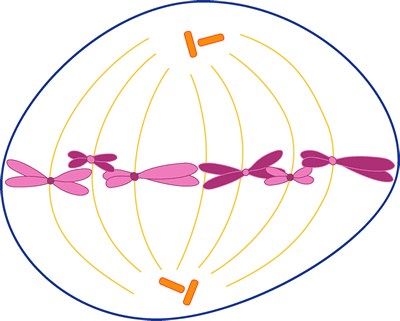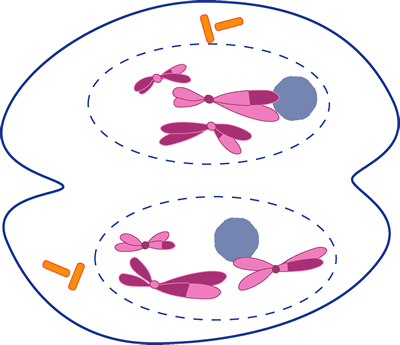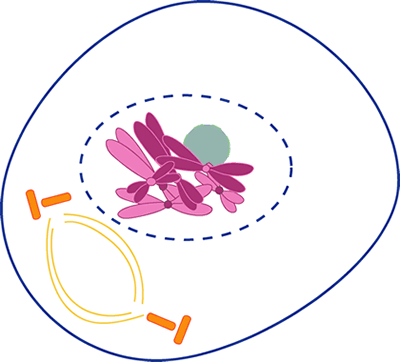What is cloning?
What is Cloning?
1. Who is Dolly?
Dolly is a cloned sheep that was founded in 1997.
2. When a zygote divides into to separate cells, it is called: Embryo Twinning
3. Somatic cells are also called Diploid cells.
4. In order to clone a gene, a gene is inserted into a plasmid.
5. In order to create an embryo from a somatic cell, the donor egg cell must have its nucleus removed.
Click and Clone
6. List all the materials needed to clone a mouse.
A mouse you will clone
an egg cell donor
a surrogate mother to grow the clone
microscope
petri dishes
sharp pipette
blunt pipette
a chemical to stimulate cell division.
7. Place the following steps in the correct order.
4. Stimulate cell division
6. Deliver baby
2. Remove and discard the nucleus from the egg cell
1. Isolate donor cells from egg donor and germ cell donor
3. Transfer the somatic cell nucleus into the egg cell
5. Implant embryo into a surrogate mother
8. There are two time gaps in the process of cloning. What are they? (ie. what do you have to wait for?)
You must wait for the new DNA and the egg cell to adjust with one another, and wait until the cell has divided a few times after introducing the DNA and egg to the chemical stimulant to help stimulate cell division.
9. What color with the cloned mouse be? Brown
What is the name of this mouse? Mini Mimi
Why Clone?
10. Why is cloning extinct animals problematic?
11. What are some reasons a person might want to clone a human?
A couple that is infertile, to replace a deceased child, and to help gay couples become parents.
The Clone Zone
12. What animal was cloned in 1885?
The sea urchin was cloned in 1885.
13. How did Spemann separate the two cells of the embryo of a salamander in 1902?
He separated the two cells by creating a tiny noose, which was made out of a single strand of baby hair. The baby hair tightened the it between the two cells of the embryo, until they were separated.
14. The process of removing a nucleus is called is called enucleating.
15. In 1952, the nucleus of a frog embryo cell was placed into a donor cell. Did it work to clone the animal?
Not entirely, they successfully cloned them, but the ones who did survive had abnormalities.
16. Can the nucleus of an adult cell be injected into an egg cell and produce a clone?
Yes
17. Why are mammals hard to clone?
The DNA is very intricate and mammals oftentimes progress differently depending on environment.
18. What were the names of the first two cloned cows?
Fusion and Copy were the names of the first two cloned cows.
19. In what year was the National Bioethics Advisory Council formed?
It was formed in 1995.
20. The first mammal clone to be produced from an adult (somatic) cell?
Dolly the sheep was the first mammal clone to be produced from an adult somatic cell.
21. What do scientists do to adult cells to make them "behave" like embryos?
Scientists remove the nucleus of somatic cell, and transfer it into thenucleated egg cell, reprogramming it to behave like embryos.
22. Transgenic, cloned sheep were used to produce what medical protein?
Farm animals such as cows, sheep and goats are currently being genetically engineered to produce drugs or proteins that are useful in medicine.
23. What is a stem cell?
Stem cells are the body's building blocks, responsible for developing, maintaining and repairing the body throughout life. As a result, they might be used to repair damaged or diseased organs and tissues.
Cloning Myths
24. Briefly describe in your own words, why CC the cat was not identical in color to Rainbow, even though she was a clone/
The answer lies on the X chromosome. In cats, a gene that helps determine coat color resides on this chromosome. Both CC and Rainbow, being females, have two X chromosomes. (Males have one X and one Y chromosome.) Since the two cats have the exact same X chromosomes, they have the same two coat color genes, one specifying black and the other specifying orange .Very early in her development, each of Rainbow's cells "turned off" one entire X chromosome - and therefore, turned off either the black color gene or the orange one. This process, called X-inactivation, happens normally in females, in order to prevent them from having twice as much X-chromosome activity as males. It also happens randomly, meaning that not every cell turns off the same X chromosome.
25. What is "nature vs nurture"?
Basically, this means that while genetics can help determine traits, environmental influences have a considerable impact on shaping anindividuals physical appearance and personality. For example, do you know any identical twins? They are genetically the same, but do they really look and act exactly alike?
Is it Cloning or Not?
26. For each of the following scenarios, indicate YES (it is cloning) or NO (it is not cloning)
NOT Sperm taken from a mole goat is combined with a female's egg in apetri dish. The resulting embryo is implanted into the female's uterus to develop
YES A sheep embryo, composed of 16 cells, is removed from the mother's uterus and separated into individual cells. Each cell is allowed to multiply, creating 16 separate embryos, which are then implanted in different female sheep to develop to maturity.
NOT A cow with many desirable traits is stimulated with hormones to produce a number of egg cells. Each of these eggs is fertilized and implanted into a surrogate mother.
NOT In vitro fertilization
YES Cell nuclei from an extinct woolly mammoth are placed into enucleatedcow cells.
27. Define or describe each of the following processes (you may need to reset the Cloning or Not Screen)
Invitro fertilization- The embryo, which is created through the fusion of male'ssperm and the female's egg, will not be identical to any other organism.
Embryo splitting-The 16 cells are removed from the mother's uterus and separated into individual cells. Then each cell is allowed to multiply, and this will create 16 separate embryos. After this has happened, then the embryos will be inserted into a different female to develop into maturity.
Somatic Cell Nuclear Transfer-"In genetics and deve
Multiple Ovulation Embryo Transfer-"Multiple ovulation embryo transfer is a way to produce an animal of certain genetic qualities faster. The multiple ovulation part is where the female animal is manipulated hormonally to produce more than the usual number of eggs during ovulation. The chosenmale's semen, containing the genes you are selecting are placed to fertilise the eggs in the female. the new embryos are then removed from the female before they are attached to the uterine wall. This is the embryo transfer part. Other female animals are used because their oestrous cycle is at the right point to recieve the embryo. Hormones can be used to manipulate the recieving animal's oestrous cycle as well."
Artificial Insemination-"Artificial insemination, or AI, is the process by which sperm is placed into the reproductive tract of a female for the purpose of impregnating the female by using means other than sexual intercourse orNI."
What Are the Risks of Cloning?
28. What is one reason why cloning animals has such a high failure rate?
Here is a list of reasons why cloning animals has such a high failure rate:
- he enucleated egg and the transferred nucleus may not be compatible
- An egg with a newly transferred nucleus may not begin to divide or develop properly
- Implantation of the embryo into the surrogate mother might fail
- The pregnancy itself might fail
29. What is a telomere and how does it affect cloned animals?
Telomere is basically is the DNA sequences at both ends of the chromosome that will shrink the length of the sequence every time the DNA is copied. ". Chromosomes from cloned cattle or mice had longer telomeres than normal. These cells showed other signs of youth and seemed to have an extended lifespan compared with cells from a naturally conceived cow. On the other hand, Dolly the sheep's chromosomes had shorter telomere lengths than normal. This means that Dolly's cells were aging faster than the cells from a normal sheep."
30. Pick one of the questions to ponder and ....ponder it. Write a brief essay on your thoughts and opinions.
What are the benefits? What are the risks? Whom will the technology help? Does it have the potential to hurt anyone?
What does this mean for me? For my family? For others around me? Why might others not share my view?
There are several benefits to the cloning of humans, in actual. The first one is rejuvation. This will help aging people look younger by the production of cloned tissue. "According to Dr. Richard Seed, one of the leading proponents of human cloning technology, one day it should be possible to reverse the aging process." The second one is for heartattack treatment. Dying from a heartattack is the #1 killer. Scientists will be able to clone healthy heart cells and remove the "bad" cells and replace them with the healthy ones. Another reason is for the cloning of human stem cells. Recent experiments have showed that nascent cells can grow and produce human organs and tissue. This can be used for replacing/repairing damaged organs/tissue. Infertility can help couples have children and reproduce. "The success rate of current infertility treatments is very low. Further, the couple has to go through tormenting procedures for a small chance of getting a child. The advent of human cloning technology will make it possible for infertile couples to have child than ever before." Using the cloning treatments during surgeries are also extremely benefical. Silicon gels and other cosemtics are used during surgery. These are known for causing immune disease. If you lose a limb, then scientists have been able to get you a false arm, but it is not as functional. In the future, they want to have something that will be already present in the body. Amputees can have regenerated arms/legs/fingers/toes etc. It is estimated that a person has 8 defective genes inside their body. With cloning, this rate can go down, even become 0 defective genes. People who are interested in plastic/cosmetic surgey will love this. New technologies can come from cloning, like implants. A problem in society is people judging each other by how they look. Women can have their "good" genes cloned, it lower the change of their children being born with any type of genetic diseases. Another things is with the bone marrow. There are very few who will suffer through the pain just to donate. Bone marrow is needed to help Leukemia patients. Scientists will be able to clone the cells in bone marrow. One of the most important would be helping with cancers and other diseases that preferred a new vital organ. If we are able to create a new heart, then someone's live can be spared. We can clone, skin for skin cancer patients, lungs, kidneys, etc. Think of all the people we could save from dying of deadly disease. Roughly 7.2 to 7.5 million people worldwide die of cancer each year. It may just seem like a number to you, but it will really hit you when it happens to someone you know or you. Wouldn't you want to an organ secured for you, if you ever needed it? Waiting on the donors list can take a long time. There have been success stories from around the world. Now is the time to try something new that could eventually change medicine was we know it.


